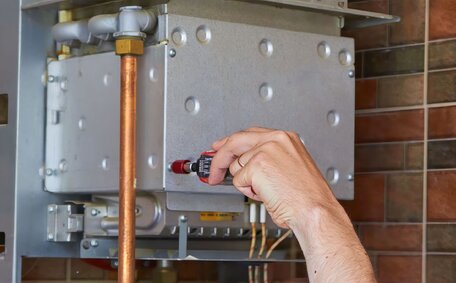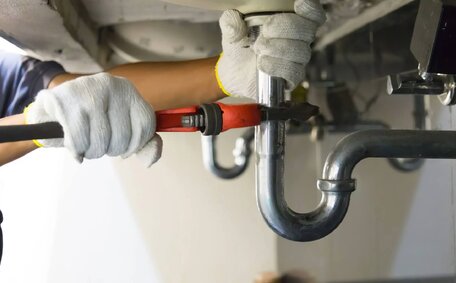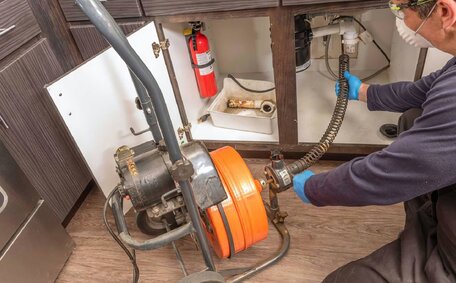Introduction to Pipe Repairs: Patching vs Relining
Homeowners often grapple with regular plumbing issues, including cracked, leaking pipes or blocked drain pipes. When it comes time to repair broken pipes, two of the main options to consider are pipe patching and pipe relining.
At Dulwich Hill Plumbing, our certified plumbers are dedicated to crafting customised solutions to pipe problems for Sydney’s Inner West community.
This guide delves into pipe patching and relining, comparing aspects such as cost, procedures, and applicability to inform your plumbing decision-making.
Both patching and relining offer alternatives to full pipe replacement, reducing the need for disruptive excavations. Read on for a breakdown of the pros, cons and applications of each method.
Defining Key Differences Between Pipe Patching and Relining
Pipe patching involves sealing a small, localised section of damaged pipe using an epoxy patch or clamp. It targets the exact problem area only, without addressing wider pipe damage. The defective section is simply patched to restore function.
In comparison, the process pipe relining involves coating the full length of the piping with an epoxy resin to mend damage across larger spans or even entire runs. A flexible tube inside lined with resin is fed into the pipe then inflated to coat the inner walls with the material. Once cured, it forms a smooth, watertight seal.
Pipe patching is ideal for targeted issues, such as cracks or holes that compromise drainage flow. As trenchless techniques, both avoid major digging or demolition.
In contrast, relining reinforces the full length of deteriorated pipes, beyond just patching a single point of leakage or blockage.
When to Choose Pipe Patching
Pipe patching is effectively used for specific damaged areas where issues such as corrosion, cracks, or holes result in leaks or drainage complications. It allows plumbers to target repairs to the exact problematic section rather than replacing entire pipe runs.
One of the primary reasons why we advocate pipe patching is its less invasive nature. A single small entry point for the epoxy patch suffices, significantly reducing demolition work compared to full pipe replacement. This also takes less time and allows pipes difficult to access locations to be repaired.
Our sophisticated drain cameras precisely locate areas suitable for patching. If the defective area is accessible and what pipe repairs are limited, patching represents a cost-effective and convenient fix.
For significant pipe wear over longer spans, pipe relining is the recommended approach.
Benefits and Drawbacks of Pipe Patching
Benefits of pipe patching
- Cost-effective fix for minor issues
- Targets isolated areas of damage
- Less invasive than pipe replacement
- Minimal demolition to surroundings
- Suitable for difficult to access areas
- Rapid repairs taking less time
Potential drawbacks
- Only repairs localised damage, doesn’t line full pipe sections
- May not withstand extensive deterioration long-term
- Ongoing issues if wider corrosion present
- Multiple patches needed for widespread problems
Although convenient in the short term, pipe patching might require ongoing preventative maintenance to prevent future issues. For extensive pipe damage, relining often represents better value despite higher initial costs.
Our experienced plumbers can advise if patching or relining is most suitable depending on the pipe layout and cracked leaking deterioration levels assessed through CCTV drain inspections.
Types of Damage Suited to Pipe Patching
When it comes to pipe damage, there are a few specific situations where applying a localised patch is the most practical solution:
- Minor leaks - An epoxy or stainless steel patch can easily seal cracks, holes or joints that are leaking.
- Localised blockages caused by intruding tree roots that require opening an access point in the pipe for clearing.
- Corrosion damage affecting drainage flow in one section of pipe.
- Small areas with a broken pipe or cracks without further deterioration.
Patching facilitates rapid repairs through existing drainage infrastructure without necessitating extensive pipe replacement. The less invasive approach also means minimal impact on surrounding infrastructure or your garden areas.
For localized pipe damage, we recommend patching as an efficient and effective repair strategy.
When to Select Pipe Relining
Pipe relining stands out as the optimal choice for comprehensive repair of extensive deterioration or corrosion throughout significant sections of piping. Distinct from patching, relining fully renews old, damaged pipes with an epoxy barrier to prevent future leaks, blockages, or collapse.
Pipe relining is particularly recommended when facing:
- Existing pipes weakened by extensive corrosion or cracks
- Whole sections affected by root invasion or mineral build-up
- Previous patches failing with ongoing issues emerging
- Full pipe replacement either impossible or highly invasive
Relining enhances the structural stability and flow capacity, thereby prolonging your pipes’ lifespan with minimal surface excavation or demolition required. It also enhances drainage function, adding value for property owners.
Summarily, relining is a wise, long-term solution for extensive damage affecting large sections or entire pipelines. Speak to our team at Dulwich Hill Plumbing to determine if your pipes require relining.
Advantages and Disadvantages of Pipe Relining
Benefits of pipe relining
- More cost-effective than full pipe replacement
- Extends pipe lifespan without digging
- Better flow capacity and drainage
- Prevents future leaks or blockages
- Minimal surface damage and disruption
- Structural integrity restored
- Often less hassle and quicker than replacing
Potential downsides of relining
- Higher initial cost than patching
- Not suitable for severely damaged pipes
- Access still needed to pipe line
- Specialist equipment and skills required
Despite its higher immediate expense compared to patching, relining offsets the costs and disruption tied to new pipe replacement. The smooth epoxy barrier also adds 50 years or more of life expectancy for drainage systems.
When weighing up pipe relining costs in the Inner West, the long-term benefits often outweigh short-term savings from basic patches. Speak to our Dulwich Hill Plumbing team if your pipes show widespread deterioration or damage.
Scenarios Where Pipe Relining Excels
Pipe relining is an optimal repair solution for several common plumbing scenarios, including:
- Extensive corrosion - Relining can rejuvenate pipes eaten away across entire sections or lengths.
- Repeated leaks/blockages - It prevents future issues by sealing damaged pipes with a protective barrier.
- new pipes under built structures - The trenchless approach avoids demolishing walls, floors, driveways etc for pipe access.
- Invasive tree root damage - Epoxy coating prevents further root infiltration and associated drainage issues.
- Poor drainage flow - Internal smooth lining greatly improves liquid waste flow and pipe capacity.
Unlike patching isolated issues, relining fully renews pipes for enhanced function and longevity without digging. Where pipes are severely compromised but replacement is impractical, it offers a durable no-fuss solution.
For deteriorated plumbing plagued by leaks or blocking, speak to our Dulwich Hill Plumbing team about the extensive benefits of pipe relining today.
Cost Comparison: Pipe Patching vs Relining
When weighing up pipe repairs, a key consideration is cost. However for widespread deterioration, relining becomes the more cost-effective option despite higher initial outlay.
Patching is an economical repair for localized issues, typically starting around $150, with prices varying based on the extent of damage. In contrast, relining costs fall between $250 and $350 per metre, addressing anywhere from 15 to 20 metres of pipe in a single session.
While patching is cheaper upfront, it doesnt prevent future leakage or pipe collapse. Repeated repairs can eventuate, whereas relining adds 50 years or more of life expectancy. Although initially more expensive, relining with robust epoxy barriers addresses root problems and cuts long-term costs by avoiding recurrent repairs.
Speak to our Dulwich Hill Plumbing team about onsite CCTV inspection to determine the best value repair strategy tailored to your pipe layout, damage and budget. Get in touch today for professional drain and sewer repairs with lasting results.
How Intrusive Are Patching and Relining?
A major advantage of patching and relining compared to traditional pipe replacement is their non-invasive nature. These trenchless repair techniques require only small access holes cut in the pipes to complete repairs, with minimal digging or disruption.
For patching, openings are core drilled to expose the damaged area pipe so the lining or patch can be applied. The process usually takes under three hours with a plumber accessing the pipe via drainage infrastructure such as shared chambers or access pits rather than directly in your home.
However, there is no need to demolish building walls and pipe runs under structures are still accessible.
Plumbers might need access to your house for relining work close to appliance connections.
Overall, both patching and relining methods cause minimal surface disturbance, especially when compared to the significant disruption of digging up and replacing old pipes. By leaving surroundings like paving, foundations and garden beds intact, they are far less labour-intensive and intrusive. This allows rapid repairs even in hard to access areas.
Signs You Need Pipe Repairs
There are several clear signs indicating your pipes require professional repairs or relining:
- Visible water damage like stains on walls or ceilings
- Strong sewage smells emanating from your drain
- Gurgling noises from toilet or sinks draining
- Leaking pipes under sinks or appliances
- Clogged drains and slowly draining water
- Low water pressure through taps and showers
- Sagging pipe sections that indicate structural problems
Catching minor pipe problems early by recognising these warning signs reduces the likelihood of a burst pipe and serious failures down the track requiring urgent work. Our Dulwich Hill plumbing experts are here to inspect issues and provide pipe patching, relining or replacement as needed to restore proper drainage function.
Contact us today for affordable and durable sewer pipe repairs with minimal disruption.
Choosing the Best Pipe Repair Method
When faced with pipe issues, deciding between patching or relining depends on the damage type, location, accessibility and your budget. Key factors to consider include:
- Localised vs widespread damage - Patching suits isolated problems; relining is better for extensive deterioration.
- Convenience and invasiveness - Patching involves minimal digging and property disruption.
- Short vs long-term solution - Patching offers immediate repairs but may need repeated fixes compared to one-off relining.
- Damaged section accessibility - Patching is suitable for hard-to-reach areas, whereas relining requires access to pipe endings.
- Budget - Patching is more affordable for minor issues only.
Our Dulwich Hill Plumbing team can provide expert recommendations on the optimal repair method after CCTV drainage inspection. We aim to give tailored solutions that restore your pipes effectively and conveniently while keeping costs reasonable.
Seek professional advice on pipe patching versus relining in the Inner West by emailing or calling Dulwich Hill Plumbing today.
Conclusion
Homeowners have two trenchless repair options for addressing damaged or deteriorated pipes - patching and relining.
Pipe patching offers a durable repair, providing a swift, cost-effective fix for minor, isolated damage such as cracks or leaks. Pipe relining takes more effort and expense but renews entire pipe sections or runs by coating them internally with a smooth epoxy layer.
It targets only the problem area without addressing wider deterioration. This is why we focus on preventing future problems while restoring structural integrity.
Considerations such as pipe accessibility, extent of damage, budget, and convenience influence the choice between patching and relining. There’s no one-size-fits-all method; the best solution depends on pipe layouts and unique property factors.
Our Dulwich Hill Plumbing team, equipped with advanced technology and expertise, performs comprehensive drain inspections. We provide trusted recommendations on suitable repairs, then expertly perform patching or relining with minimal invasion to restore your plumbing fully.
For trusted local pipe repair assessments, email or call Dulwich Hill Plumbing at 1300 349 338. Backed by years servicing Sydney’s Inner West, we aim to solve pipe problems promptly and conveniently while keeping disruption and costs to a minimum.






